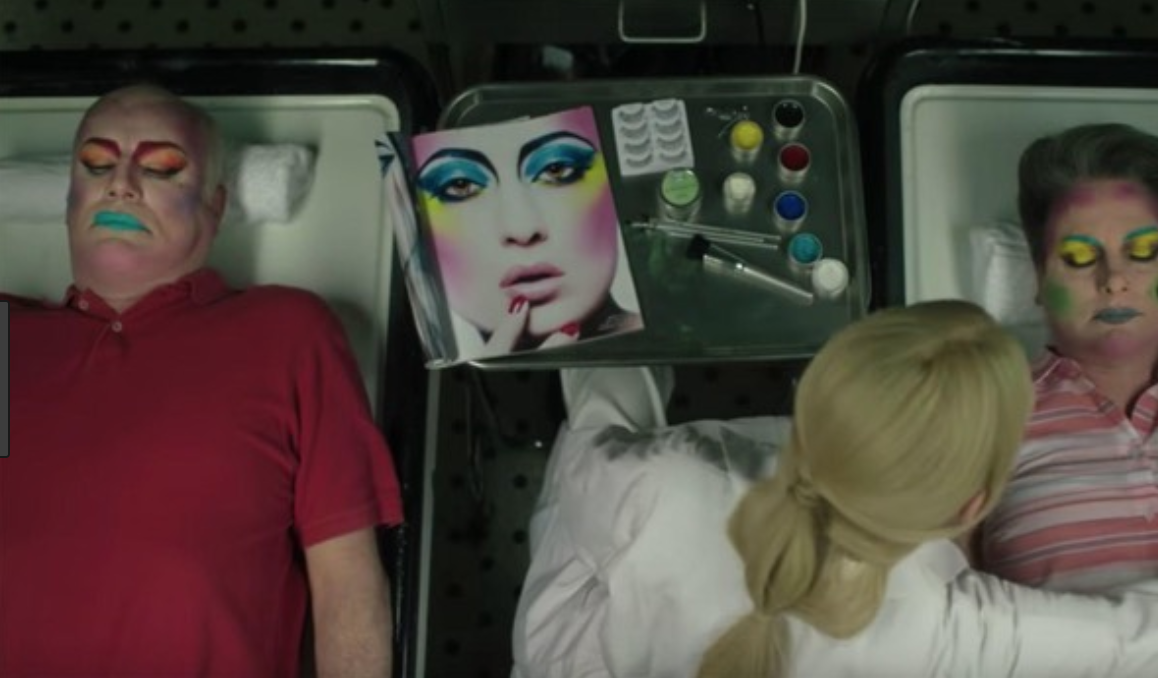Never one to shy from the hyper-metaness of existence in his work, Jim Jarmusch’s latest, The Dead Don’t Die, is in every way an unbridled allusion to the present (in addition to his favorite actors not always getting a hold of the full script before production). That said, Ronnie Peterson (Adam Driver), fellow officer to Chief Cliff Robertson (Bill Murray), is perfectly fine with breaking the illusion of a “cinematic world” to say things like, “Because it’s the theme” when Cliff asks why Sturgill Simpson’s “The Dead Don’t Die” always seems to be playing.
For Jarmusch, unlike some other artists, politicians and filmmakers, is done pretending that everything is going to be okay. That there will be a miraculous solution when the end inevitably comes at all of our own hands. And, in truth, we’re already living out the end. The eponymous dead who won’t just surrender to the reality of resources available versus number of humans on this earth and die. Let it fucking go, it’s not that fly in this place anyway.
With its careful and often deliberately slow pacing, The Dead Don’t Die is an homage to both zombie/horror movies of the past (particularly those of the George Romero variety, who gets name checked as a result of, of all people, Selena Gomez’s character), as well as life itself. Crawling along at a deadening rate (pun intended) before finally something catastrophic and momentous enough happens to end it (usually some old age disease like cancer or heart failure). Because, for whatever reason, no matter how terrible things get, humans just don’t have the encoding to off themselves and make way for others who might actually be fresher to try their hand at this thing called survival–and, now and again, if one is rich, self-actualization.
For most of the residents of Centerville–“A Real Nice Place”–a sense of purpose isn’t exactly “their thing,” so much as going through the humdrum motions of small town life (the living population barely clears eight hundred). From the waitresses at the diner to racist Farmer Miller (Steve Buscemi), sporting his Keep America White Again hat, no one in this town is really contributing much to society. Arguably, the one giving the most is “the philosopher” of the casting tropes, Hermit Bob (Tom Waits), who lives off the bounty of the forest and occasionally encounters worthwhile literature like Moby Dick, mumbling to himself when he sees it. He clearly views the book as a portent and parallel to the unavoidable plague upon Centerville at the moment. One that none of the nearby youths at a detention center can avoid despite it not (yet) being any fault of their own (one does hate how future generations are always elevated as Christ-like beacons of innocence, as though they’re going to do much better for humanity if only “given the chance”). They seem to be the Generation Z representation while the millennials, at least still out and free in the world enjoying some of what’s left of its bounty, are represented by “hipsters from Cleveland” named Jack (Austin Butler), Zoe (Gomez) and Zach (Luka Sabbat).
In the background of the plot is the constant assurance of government and corporation officials on TV and radio outlets touting that no harm has been done by their fracking. In actuality, it’s been fantastic for the economy and keeps creating jobs for people (to zone out during like zombies because it’s oh so fulfilling). All this talk of their work knocking the Earth off of its axis and altering weather and daylight patterns is pure hearsay. But the evidence before the townspeople of Centerville speaks to the contrary. On a side note, the very name Centerville seems a nod to how the focus of a major (indie) movie could shift toward such a nothing place. And how people in every town tend to view themselves as the center of the universe.
Speaking of universe, there is the seemingly otherworldly Scotswoman, Zelda Winston (Tilda Swinton), who has taken over the mortuary, Ever After. Her love of samurai swords and drag makeup is the most peculiar thing the town has ever seen. Even more so than the town drunk, Mallory (Carol Kane), rising from the dead again to demand more Chardonnay. That’s the thing about the undead: they’re a lot like the living, mindlessly craving the same things they wanted in life, including coffee (Iggy Pop being an ideal zombie to exhibit want for this particular beverage), WiFi, Xanax, Ambien and fashion. But at least they don’t pretend that they’re still alive the way humans do–humans who’ve had just about every last trace of humanity stamped out of them at this juncture. And when the reckoning comes, people like Hermit Bob will watch from afar and announce both nihilistically and accurately, “What a fucked up place the world is,” while those in the Zelda role of privilege and superiority will simply get on their spaceship and leave because this planet is way too ghetto for their taste and they can afford to bounce at any time (hence, talk of a future moon colony so far only comprising the wealthy).
And then there are the average Joes–your Cliffs and your Ronnies–who will give it their “best shot” up until the end, knowing full well that it’s still going to “turn out badly.” Maybe the only sane–even if completely weak–people are those of the Mindy Morrison (Chloë Sevigny) variety, abandoning ship early because they can’t stomach the notion that the increasing ills of the world won’t just vanish like a bad dream because that’s what movies and media have tried to assuage us with as a third act outcome for so long. The Dead Don’t Die is, for once, a film with absolutely no sugar-coating. It states only the facts: This is it. We’re fucked. The walking dead still trying to pretend we’re alive.



















